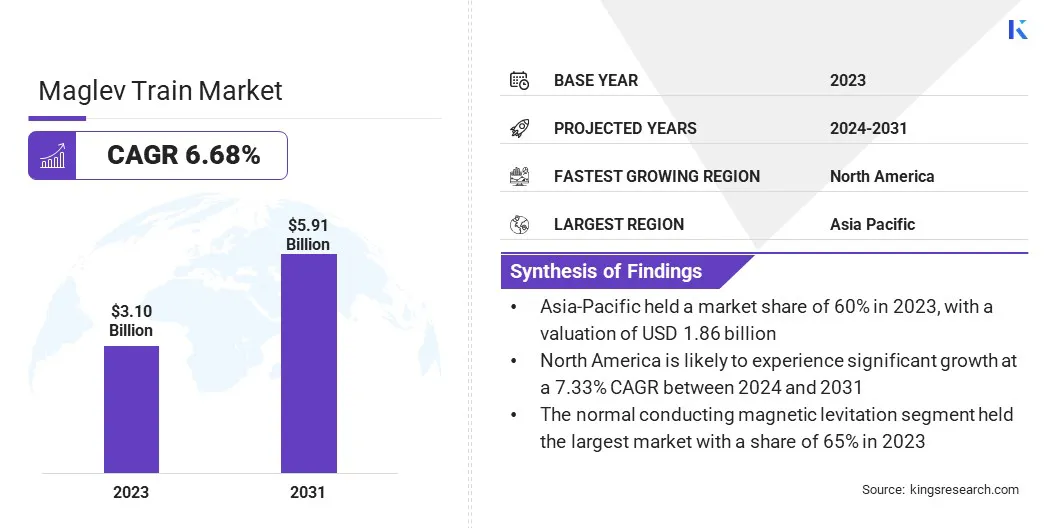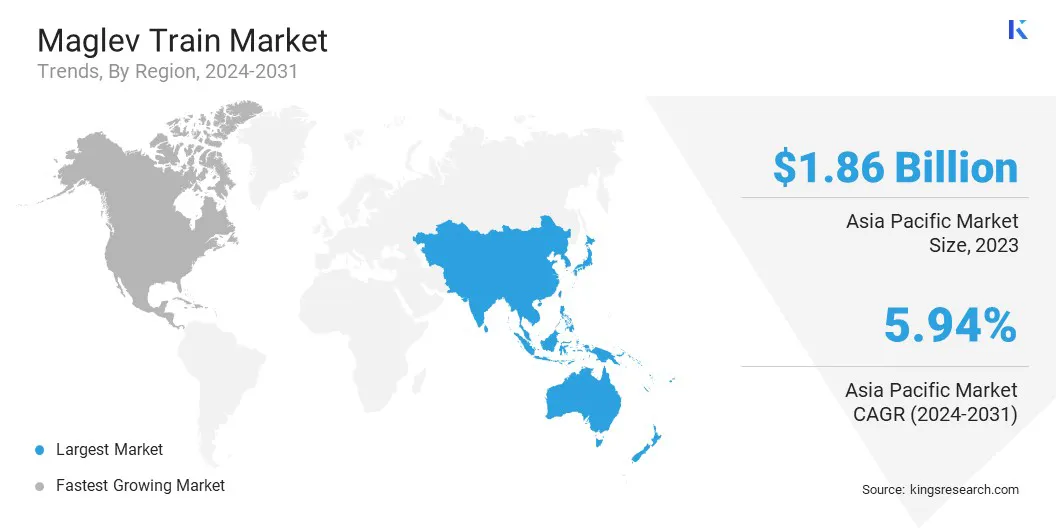Maglev Train Market Size
The global Maglev Train Market size was valued at USD 3.10 billion in 2023 and is projected to reach USD 5.91 billion by 2031, growing at a CAGR of 6.68% from 2024 to 2031. In the scope of work, the report includes products offered by companies such as SwissRapide AG, WSP, Northeast Maglev, Hyundai Motor Group, CRRC Corporation Limited, Hitachi, Ltd., Max Bögl Group, ALSTOM SA and Others.
Currently, the market scenario reflects a growing interest in high-speed transportation solutions, with maglev technology positioned as a frontrunner in this field. The market has experienced steady growth, driven by several factors such as increasing urbanization, the need for efficient mass transit systems, and government investments in transportation infrastructure.
Additionally, technological advancements in maglev technology have enhanced its feasibility and attractiveness as a sustainable transportation option. The growth outlook for the maglev train market appears promising, with continued investments expected to drive expansion. However, challenges such as high upfront costs and the need for specialized infrastructure remain hurdles to widespread adoption, requiring strategic initiatives and collaborations to overcome.

Analyst’s Review
The increasing demand for sustainable and efficient transportation solutions in urban areas is driving the growth of the maglev train market in the forecast years. Urbanization trends are leading to overcrowded cities and rising concerns regarding traffic congestion, pollution, and environmental sustainability.
As a result, there is a growing emphasis on developing high-speed, low-emission transportation systems such as maglev trains to address these challenges. Governments and urban planners are increasingly prioritizing investments in mass transit infrastructure, including maglev systems, to improve mobility and reduce carbon emissions.
This shift towards sustainable urban transportation is expected to propel the demand for maglev trains in the forthcoming years, making them a key component of future urban mobility solutions.
Market Definition
A maglev train, short for magnetic levitation train, is a form of high-speed transportation that uses magnetic fields to levitate and propel trains along a guideway, thereby eliminating the need for traditional wheels and tracks. There are two main types of maglev trains: electromagnetic suspension (EMS) and electrodynamic suspension (EDS).
EMS systems use electromagnets to levitate and stabilize the train, while EDS systems use superconducting magnets and induced currents to achieve levitation. Maglev trains find applications primarily in high-speed intercity and urban transit systems, offering faster speeds, smoother rides, and reduced energy consumption compared to conventional rail technologies.
Maglev Train Market Dynamics
Improvement in railway infrastructure in developing countries is a key factor shaping the future of transportation systems globally. Developing countries are increasingly recognizing the importance of modernizing their transportation networks to support economic growth, enhance connectivity, and address urbanization challenges.
As a result, significant investments are being made in upgrading railway infrastructure, including the development of high-speed rail lines and advanced transportation technologies such as maglev trains. These improvements aim to enhance transportation efficiency, reduce travel times, and meet the growing demand for reliable and sustainable mobility solutions in developing regions.
Additionally, investments in railway infrastructure contribute to job creation, economic development, and enhanced connectivity within and between urban centers, thereby driving growth and innovation in the transportation sector.
High capital requirement is a significant restraint hindering the adoption of maglev trains as a mainstream transportation solution. The development and deployment of maglev train systems require substantial upfront investment in specialized infrastructure, including guideways, propulsion systems, and maintenance facilities.
Additionally, the cost of research and development for maglev technology is considerable, adding to the capital requirements. These high costs pose a barrier to entry for governments and private investors considering maglev projects, especially when compared to alternative transportation options such as conventional rail or road networks.
- Moreover, the long-term financial viability and return on investment for maglev projects may be uncertain, leading to hesitation and risk aversion among potential stakeholders. Addressing the capital requirement challenge requires innovative financing mechanisms, public-private partnerships, and cost-effective project management strategies to make maglev trains a more viable and accessible transportation solution.
Segmentation Analysis
The global market is segmented based on type, application, and geography.
By Type
Based on type, the market is classified into normal conducting magnetic levitation and superconducting maglevs. The normal conducting magnetic levitation segment held the largest maglev train market with a share of 65% in 2023 on account of its widespread application in maglev train systems. Normal conducting magnetic levitation, also known as electromagnetic suspension (EMS), relies heavily on the use of electromagnets to levitate and stabilize the train above the guideway.
This technology offers a proven and reliable solution for achieving magnetic levitation in maglev trains, making it the preferred choice for several operational and planned maglev systems worldwide. The dominance of the normal conducting magnetic levitation segment is attributed to its established track record, technological maturity, and compatibility with existing infrastructure, which is driving its widespread adoption across various high-speed rail projects.
By Application
Based on application, the market is classified into urban transport, intercity, and others. The urban transport segment is expected to grow at the highest CAGR of 6.94% over the forecast period owing to the increasing demand for sustainable and efficient transportation solutions in urban areas.
Rapid urbanization, population growth, and rising concerns regarding traffic congestion and environmental sustainability are driving the need for innovative urban transit systems such as maglev trains. As cities expand and become more densely populated, there is a growing emphasis on developing high-speed, low-emission transportation networks to improve mobility and reduce carbon emissions.
Maglev trains offer significant advantages for urban transport, including faster speeds, smoother rides, and reduced energy consumption compared to conventional rail technologies. The anticipated growth of the urban transport segment reflects the increasing investments and initiatives aimed at modernizing urban transit infrastructure and addressing the mobility needs of growing populations.
Maglev Train Market Regional Analysis
Based on region, the global market is classified into North America, Europe, Asia-Pacific, MEA, and Latin America.

The Asia-Pacific Maglev Train Market share stood around 60% in 2023 in the global market, with a valuation of USD 1.86 billion, mainly driven by several factors such as rapid urbanization, economic growth, and government investments in transportation infrastructure.
The Asia-Pacific region is experiencing increasing demand for efficient and sustainable transportation solutions. Governments in countries such as China, Japan, South Korea, and India are prioritizing investments in high-speed rail and maglev train projects to address urban congestion, improve connectivity, and promote economic development.
Additionally, the Asia-Pacific region is witnessing rapid technological advancements and innovation in the transportation sector, thus contributing significantly to market growth. With ongoing urbanization and infrastructure development initiatives, Asia-Pacific is expected to maintain its leading position in the global maglev train market in the forthcoming years.
North America is likely to experience significant growth at a 7.33% CAGR between 2024 and 2031 as a result of increasing investments in transportation infrastructure and growing interest in high-speed rail technologies.
The North American region, particularly the United States and Canada, is witnessing on upgrading and expanding transportation networks to support economic growth, enhance mobility, and address environmental concerns. Governments and private stakeholders are investing heavily in various high-speed rail projects and advanced transportation technologies such as maglev trains to improve connectivity between major urban centers and reduce travel times.
Additionally, initiatives aimed at promoting sustainable transportation and reducing carbon emissions are driving the adoption of innovative transit solutions such as maglev trains in North America. With favorable market conditions and increasing support for modernizing transportation infrastructure, North America is poised to emerge as a key market for maglev trains in the forecast years.
Competitive Landscape
The maglev train market report will provide valuable insight with an emphasis on the fragmented nature of the industry. Prominent players are focusing on several key business strategies such as partnerships, mergers and acquisitions, product innovations, and joint ventures to expand their product portfolio and increase their market shares across different regions.
Companies are undertaking effective strategic initiatives involving expansions & investments, including investments in R&D activities, the establishment of new manufacturing facilities, and supply chain optimization, which could pose new opportunities for market growth.
List of Key Companies in Maglev Train Market
- SwissRapide AG
- WSP
- Northeast Maglev
- Hyundai Motor Group
- CRRC Corporation Limited
- Hitachi, Ltd.
- Max Bögl Group
- ALSTOM SA
- Medha Servo Drives Private Limited
- Central Japan Railway Company
Key Industry Developments
- February 2024 (Development): CRRC's Guangdong Qingyuan Maglev Tourist Line, which underwent a trial operation, showcased cutting-edge technology. This technology includes the latest medium and low-speed maglev train platform, constant conductive electromagnetic levitation, and vehicle-mounted short stator linear motor traction, facilitating a maximum speed of 120km/h.
- November 2023 (Expansion): Hitachi Rail secured an €861 million (USD 941.75 million) contract with Trenitalia for the delivery of 30 cutting-edge ETR1000 high-speed trains. The agreement further includes an option for ten additional trains, potentially increasing the contract value to €1.148 billion (USD 1.25 billion).
- October 2022 (Launch): CRRC debuted the globe's premier high-speed maglev system, achieving speeds of 600km/h, and setting a new standard for rapid land public transportation.
The global Maglev Train Market is segmented as:
By Type
- Normal Conducting Magnetic Levitation
- Superconducting Maglevs
By Application
- Urban Transport
- Intercity
- Others
By Region
- North America
- Europe
- France
- U.K.
- Spain
- Germany
- Italy
- Russia
- Rest of Europe
- Asia-Pacific
- China
- Japan
- India
- South Korea
- Rest of Asia-Pacific
- Middle East & Africa
- GCC
- North Africa
- South Africa
- Rest of Middle East & Africa
- Latin America
- Brazil
- Argentina
- Rest of Latin America


